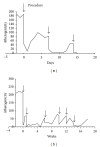Approach to reduction of blood atherogenicity
- PMID: 25101152
- PMCID: PMC4101215
- DOI: 10.1155/2014/738679
Approach to reduction of blood atherogenicity
Abstract
We have earlier found that blood sera of patients with coronary heart disease (CHD) increase lipid levels in cells cultured from subendothelial intima of human aorta. We have also revealed that the ability of blood sera to raise intracellular cholesterol; that is, their atherogenicity is caused by at least modified low density lipoprotein (LDL) circulating in the blood of patients and autoantibodies to modified LDL. In the present work we have demonstrated significant impact of nonlipid factor(s) to blood atherogenicity. We have developed an approach to removal of nonlipid atherogenicity factor(s) from blood serum based on the use of immobilized LDL. This approach was used for extracorporeal perfusion of patient's blood through the column with immobilized LDL. Pilot clinical study confirmed the efficacy of this approach for prevention of coronary atherosclerosis progression.
Figures


Similar articles
-
Blood serum atherogenicity associated with coronary atherosclerosis. Evidence for nonlipid factor providing atherogenicity of low-density lipoproteins and an approach to its elimination.Circ Res. 1988 Mar;62(3):421-9. doi: 10.1161/01.res.62.3.421. Circ Res. 1988. PMID: 3342473
-
Low-density lipoproteins isolated from the blood of patients with coronary heart disease induce the accumulation of lipids in human aortic cells.Exp Mol Pathol. 1989 Jun;50(3):337-47. doi: 10.1016/0014-4800(89)90043-9. Exp Mol Pathol. 1989. PMID: 2721653
-
Low density lipoprotein-containing circulating immune complexes: role in atherosclerosis and diagnostic value.Biomed Res Int. 2014;2014:205697. doi: 10.1155/2014/205697. Epub 2014 Jun 18. Biomed Res Int. 2014. PMID: 25054132 Free PMC article. Review.
-
Autoantibodies against low-density lipoprotein and atherogenic potential of blood.Ann Med. 1993 Dec;25(6):551-5. Ann Med. 1993. PMID: 8292305
-
Multiple-modified Low-Density Lipoprotein as Atherogenic Factor of Patients' Blood: Development of Therapeutic Approaches to Reduce Blood Atherogenicity.Curr Pharm Des. 2017;23(6):932-936. doi: 10.2174/1381612823666170124112918. Curr Pharm Des. 2017. PMID: 28120723 Review.
Cited by
-
The Atherogenic Role of Circulating Modified Lipids in Atherosclerosis.Int J Mol Sci. 2019 Jul 20;20(14):3561. doi: 10.3390/ijms20143561. Int J Mol Sci. 2019. PMID: 31330845 Free PMC article. Review.
-
Proatherogenic Sialidases and Desialylated Lipoproteins: 35 Years of Research and Current State from Bench to Bedside.Biomedicines. 2021 May 25;9(6):600. doi: 10.3390/biomedicines9060600. Biomedicines. 2021. PMID: 34070542 Free PMC article. Review.
-
Hormesis and homeopathy: The artificial twins.J Intercult Ethnopharmacol. 2015 Jan-Mar;4(1):74-7. doi: 10.5455/jice.20140929114417. Epub 2014 Nov 28. J Intercult Ethnopharmacol. 2015. PMID: 26401389 Free PMC article. Review.
-
Soy and phytoestrogens: possible side effects.Ger Med Sci. 2014 Dec 15;12:Doc18. doi: 10.3205/000203. eCollection 2014. Ger Med Sci. 2014. PMID: 25587246 Free PMC article. Review.
-
Thirty-Five-Year History of Desialylated Lipoproteins Discovered by Vladimir Tertov.Biomedicines. 2022 May 19;10(5):1174. doi: 10.3390/biomedicines10051174. Biomedicines. 2022. PMID: 35625910 Free PMC article. Review.
References
-
- Demarin V, Lisak M, Morović S, Cengić T. Low high-density lipoprotein cholesterol as the possible risk factor for stroke. Acta Clinica Croatica. 2010;49(4):429–439. - PubMed
-
- Libby P, Ridker PM, Hansson GK. Progress and challenges in translating the biology of atherosclerosis. Nature. 2011;473(7347):317–325. - PubMed
-
- Maurice P, Blaise S, Gayral S, et al. Elastin fragmentation and atherosclerosis progression: the elastokine concept. Trends in Cardiovascular Medicine. 2013;23(6):211–221. - PubMed
-
- Fogelstrand P, Borén J. Retention of atherogenic lipoproteins in the artery wall and its role in atherogenesis. Nutrition, Metabolism and Cardiovascular Diseases. 2012;22(1):1–7. - PubMed
-
- Chazov EI, Tertov VV, Orekhov AN, et al. Atherogenicity of blood serum from patients with coronary heart disease. The Lancet. 1986;2(8507):595–598. - PubMed
Publication types
MeSH terms
Substances
LinkOut - more resources
Full Text Sources
Other Literature Sources
Medical

